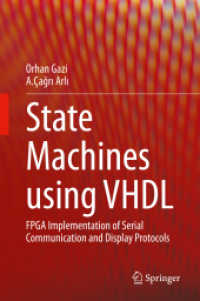Full Description
The Compound-Nuclear Reaction and Related Topics (CNR*) international workshop series was initiated in 2007 with a meeting near Yosemite National Park. It has since been held in Bordeaux (2009), Prague (2011), Sao Paulo (2013), Tokyo (2015), and Berkeley, California (2018). The workshop series brings together experts in nuclear theory, experiment, data evaluations, and applications, and fosters interactions among these groups. Topics of interest include: nuclear reaction mechanisms, optical model, direct reactions and the compound nucleus, pre-equilibrium reactions, fusion and fission, cross section measurements (direct and indirect methods), Hauser-Feshbach theory (limits and extensions), compound-nuclear decays, particle and gamma emission, level densities, strength functions, nuclear structure for compound-nuclear reactions, nuclear energy, nuclear astrophysics, and other topics. This peer-reviewed proceedings volume presents papers and poster summaries from the 6th International Workshop on Compound-Nuclear Reactions and Related Topics CNR*18, held on September 24-28, 2018, at Lawrence Berkeley National Lab, Berkeley, CA.
Contents
Part1. Modeling Compound-Nuclear Reactions.- Chapter1. Towards more predictive nuclear reaction modelling.- Chapter2. Modelling compound nuclear reactions with EMPIRE.- Chapter3. CoH3: The Coupled-Channels and Hauser-Feshbach Code.- Part2. Beyond Statistical Descriptions.- Chapter4. Recent advances in R-matrix data analysis.- Chapter5. The transition from isolated resonances to the continuum.- Chapter6. Cross section correlation functions and deviations from the Porter-Thomas distribution.- Chapter7. Moldauer's sum rule implies superradiance in compound nuclear reactions 48.- Chapter8. Multi-step direct reaction models including collectivity in nucleon induced reactions.- Chapter9. New symmetry-adapted ab initio approach to nuclear reactions for intermediate-mass nuclei.- Part3. Optical Models.- Chapter10. Linking nuclear reactions and nuclear structure to study exotic nuclei using the dispersive optical model.- Chapter11. Microscopic optical potential from chiral effective field theory.- Part4. Level Densities.- Chapter12. Nuclear level densities: from empirical models to microscopic methods.- Chapter13. Problem of level densities in compound nuclear reactions.- Chapter14. Nuclear shell model and level density.- Chapter15. Constraining level densities using spectral data.- Chapter16. Rotational enhancement factor for nuclear level density.- Chapter17. Role of fluctuations on the pairing properties of nuclei in the random spacing model.- Part5. Gamma-ray Strength Functions.- Chapter18. Gamma strength functions and the Brink-Axel hypothesis.- Chapter19. Gamma-ray strength functions and GDR cross sections in the IAEA photonuclear data project.- Chapter20. Neutron capture on actinides studied with DANCE.- Chapter21. Deconvolution of the photon strength function.- Part6. Oslo Method.- Chapter22. Attempting to close the loop on the Oslo technique at 198Au: constraining the nuclear spin distribution.- Chapter23. Impact of restricted spin-ranges in the Oslo method: The example of (d,p)240Pu.- Chapter24. Systematics of gamma-ray strength functions within the shell model.- Part7. Surrogate Nuclear Reactions.- Chapter25. Future perspectives for surrogate-reaction studies at storage rings.- Chapter26. Prospects for surrogate neutron capture measurements with radioactive ion beams and GODDESS.- Chapter27. Surrogate reaction method for neutron capture and other reactions on unstable nuclei.- Chapter28. Neutron capture cross sections from surrogate reaction data and theory: connecting the pieces with a Markov-Chain Monte Carlo approach.- Chapter29. Neutron transfer reactions for deformed nuclei using a Sturmian basis.- Part8. Fusion, Isotope Production, and Superheavy Nuclei.- Chapter30. PCN calculations for Z=111 to Z=118.- Chapter31. On the role of the curvature corrections in the surface tension coefficient upon the orientation effects in the fusion reactions.- Chapter32. Excitation function measurements of alpha-induced reaction on naturalcopper and titanium up to 46 MeV.- Chapter33. Measurement of the excitation function of 96Zr(alpha,x)99Mo reaction up to 32 MeV.- Part9. Fission.- Chapter34. A grand tour of nuclear fission physics.- Chapter35. Microscopic calculation of fission mass distributions at increasing excitation energies.- Chapter36. Microscopic description of fission for the r-process in neutron star mergers 242.- Chapter37. Event-by-event modeling with FREYA.- Chapter38. Capabilities of the NIFFTE FissionTPC.- Part10. Experimental Techniques and Facilities.- Chapter39. Resonance measurements at Rensselaer Polytechnic Institute.- Chapter40. Experimental facilities at iThemba LABS and measurements to constrain astrophysical processes.- Chapter41. Late gamma rays from neutron-induced fission and capture from 235U.







